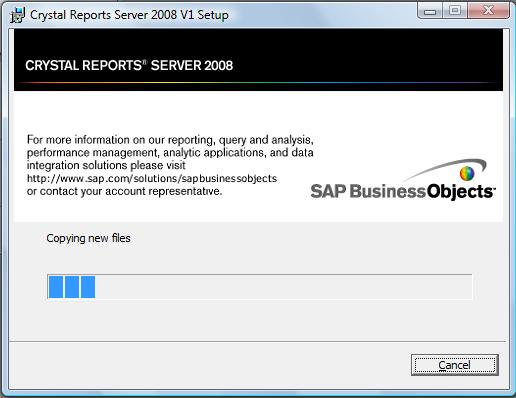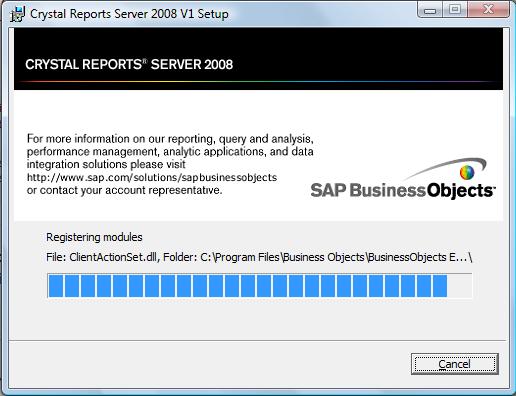In the fifth and final challenge of Reportapalooza, I’ll be writing a three part series of blog posts about the product at the heart of the SAP Crystal product line – SAP Crystal Reports Server.
My experience with BusinessObjects software goes back to versions 6.1 and 6.5 and the days of Application Foundation and the BOMain.key. Then in 2006, I had the good fortune of being introduced to BusinessObjects XI and the new CORBA architecture. This led to an ongoing string of (mostly) enjoyable experiences installing, deploying, migrating to, and administering BusinessObjects XI R2, XI 3.0, and XI 3.1. These experiences also included many years of developing Universes, building Desktop Intelligence reports, Web Intelligence documents, and finally Xcelsius 4.5 and 2008 dashboards. But my experience with SAP Crystal Reports only goes back to version XI and I’ve never had the opportunity to even see SAP Crystal Reports Server. So I jumped at the opportunity to install and peruse SAP Crystal Reports Server as part of the “Reporting Remix†and Reportapalooza.
Diving right in, I installed “SAP Crystal Reports Server 2008 V1†on my favorite box. My first attempt failed though because I tried to install it on a machine that already had SAP BusinessObjects XI 3.1 installed. My mistake, I should’ve known better. 🙂  Not a problem, I moved to another PC.
As the installation began, I started noticing some very familiar screens. These were some of the same exact windows and options that are offered when SAP BusinessObjects XI 3.x is installed. Below is a description of a few of the dialog screens presented during installation.
- Install Type selection – Provides the option to install a MySQL Database Server.
- Server Component Configuration – CMS Port selection and administrator account setup.
- Server Intelligence Agent – An “umbrella†service that helps manage services (or servers) by automating starting, restarting, and stopping of servers.
- Web Application Server selection – Java Web Application Server is the default and “WACS†is recommended deployment type. However, the option to install a Tomcat server and deploy to it is provided. Additional options are also provided, such as:
- Allowing you to deploy to a pre-installed Web App Server
- The option to manually deploy the WAR file web components after installation
- Install an IIS Web App Server (assuming ASP.NET v1.1 already exists)
- MySQL Database Configuration – Used for storing system data.
- Web Application Container Server Configuration – HTTP port setting. 6405 is the default.
After making it through the initial series of settings, installation is ready to begin. The screens continue to remind me of installing BOE but they all say “Crystal Reports Server 2008 V1 Setupâ€. Pictured below is the Server Intelligence Agent dialog screen showing the option to rename the Node Name and manually adjust the Port number. I changed the Node Name but kept the default Port #.

The screenshot below shows the Web Application Server deployment options.

The two screen shots below show the installation in progress. Expect installation to take from 30 minutes to 1 hour.


As my installation moved very close to completion, I was prompted (on Vista) by my Windows Firewall to either Keep Blocking or Unblock “BusinessObjects Enterpriseâ€. “BusinessObjects Enterpriseâ€? Wow, so far, it’s almost exactly like BOE!

Suddenly I remembered the driving force behind the architecture change from BusinessObjects 6.5 to the smooth, elegant, and .WAR filled CORBA architecture in XI. It was because of the powerful and stable SAP Crystal Reports Server.
Installation complete! It’s time to click Start and have a look at what was installed. The screen shot below shows full list of tools installed. The items that jumped out to me are:
- Central Configuration Manger (CCM) – Windows based server management utility
- Central Management Console (CMC) – Web based administrative console
- Import Wizard – Tool for migrating objects from one environment to another
- Java Infoview – The reporting portal (and same favicon used by InfoView in BusinessObjects)

The first thing I did was click “Java Infoview†and logon as the administrator. At first glance, it’s identical to SAP BusinessObjects Enterprise XI 3.1. But within minutes I began to notice a couple subtle differences. For one, there were a couple key products missing that I’m used to seeing. Such as:
- Universe Designer
- Web Intelligence
Then I realized how long Crystal Reports has been around. And how many clients use Crystal Reports to develop highly refined pixel perfect reports. What is the best method for delivering reports to users in a zero-client environment and not requiring the installation of Crystal Reports on every users PC? The answer is SAP Crystal Reports Server.
In my next two posts I will begin describing some of the common features and primary functions in SAP Crystal Reports and how it relates to an enhanced user experience.
Thank you,
Jim Brogden
jim.brogden@daugherty.com


Pingback: Tweets that mention Getting Started with SAP Crystal Reports Server – MyXcelsius.Com -- Topsy.com()